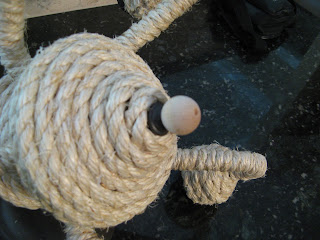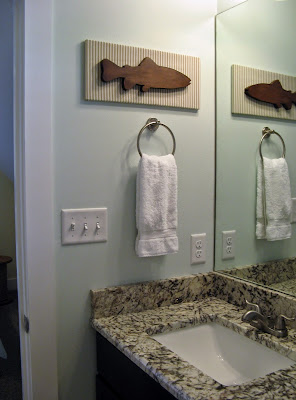There are a number of posts out there about how to go about making these types of wrapped rope chandeliers. I have read quite a few and I have accumulated some of the tips I found, along with my own tips right here:
I realized in order to keep the rope horizontal - I had to piece each section as I moved down the lamp. In other words - each layer is an individual piece of rope. To do this. Each row of rope had to be custom fit and the ends carefully pieced together to avoid the obvious look of seams.
I did the ends of the arms first (the "cups" that hold the light bulbs and I have to admit - I did not do a neat-and-tidy job of piecing the rope).
As I moved forward, I worked harder cutting & piecing the rope (by cutting the ends at an angle) and I got pretty good at disguising the seems on the base of the lamp. It definitely takes some time to do this right. I go into more detail on this below in STEP 4.
PROCESS
SUPPLIES
Brass Chandelier - Habitat for Humanity Restore $15Spray Primer and Satin Brown Spray Paint - $9
Fifty Feet of 3/8 Inch Sisal Rope - $8 per roll (one roll), I found mine at Lowe's
Light Bulbs - package of six candle style - $6
Small Wooden Ball - free (from my craft stash). This was used as a sort of finial on the bottom of the chandelier.
Multi-meter - borrowed from a friend to test the wiring
Hot Glue Gun & Lots of Hot Glue Sticks - (from my craft stash). Funny story about the hot glue sticks - about 20 years ago, I ordered a box of glue sticks from a craft store. I had not paid attention to the size of the box, or the number of glue sticks it included; I was just sick of running to the craft store to buy 10 glue sticks at a time for a dollar. In the end - I was the proud owner of a GIANT box of glue sticks. Over the years, I have handed out baggies full of glue sticks to friends and family, and I still have half a shoe box full of glue sticks. For this project I used quite a bit of hot glue.
TOTAL SPENT ON CHANDELIER- $38
STEP 1: TEST THE WIRING
I used a multi-meter borrowed from a friend to test the wiring. I mean - my husband used our friend's multi-meter to test the wiring (he's an electrical engineer so I think it is technically his job to do that kind of stuff for me :o) If you are utilizing a thrift store chandelier like I did - this is an important step. I would hate to go through this whole process, only to determine the wiring doesn't work.STEP 2: PREP THE BASE
Tape off areas of the lamp you do not want to paint. For me this included the wire up the chain, the exposed wiring at the top of the lamp, and the areas where the bulbs are placed.I chose to spray paint the base a dark brown. Some will suggest painting it an identical color of the rope you are using. I went with a dark brown with my natural color rope, as I decided this is the color I wanted for certain parts of the exposed base. In my opinion - the importance is to have a base that is a consistent color and if any of the based is going to be exposed - make it that color.
I highly recommend hanging the chandelier when you paint it. It will save you time and aggravation when painting (no painting in sections and worrying about letting it dry and turning it over). Also, another important tip - don't use the entire can of spray paint. Make sure you have some leftover for touch ups after you finish wrapping the rope.
STEP 3: CHOOSE YOUR ADHESIVE
In my opinion, hot glue is the way to go. You can use other types of adhesives but will definitely need to use clothespins (or something like them) to hold the rope while the glue dries. I like to use hot glue because you can easily glue as you go with each wrap of rope and it holds rather quickly (never mind the burnt fingers - it just comes with the territory). I had clothespins on hand but I didn't use them a whole lot.As far as how to use the glue - I really think it is important to glue as you go to avoid noticeable gaps. The idea of gluing one end and wrapping large areas to only glue again at the other end is a nice idea, but I'm skeptical this would yield good results.
STEP 4: START WRAPPING
All chandeliers are different - you need to plan out a strategy of how each section is wrapped and pay particular attention to the transitions from one part to another. Remember - the rule is no gaps. I also had to pay attention to the idea that some parts would be hard to get to, so I did those sections first.Choose your rope and start wrapping. I have seen it suggested to use 1/4 inch rope for some of these projects. As I mentioned above, I elected to use 3/8 inch three-strand sisal rope. However - I found the arms of my chandelier were too narrow and made it impossible to use the wide 3/8 inch rope here. It was necessary to unravel this rope and use a single strand on the arms.
I think this strategy (of using the smaller unraveled strands on the arms) adds interest and texture, and probably saved me a few bucks in rope as well. In summary, everything but the narrow arms were wrapped in the wide 3/8 in rope. Only the five narrow arms were wrapped in the smaller unraveled strands.
Now let's talk about cutting and piecing the rope to disguise the seams. On the ends of the arms (the cups that hold the bulbs) you can see the start and stop of the ends of the rope. I had not taken the time to figure out the technique of hiding the seams (where the ends of the rope met on each row).
As I progressed on the lamp - I got better at this. You can hardly find where the ends of the rope start and stop. I recommend practicing making rings of rope where you figure out how to cut the rope, seals the ends with glue, and ultimately piece them together.
 |
| Cut the ends at an angle and apply hot glue to the ends to keep them from fraying |
 |
| Once you put them together, they should be hard to distinguish between the continuous sections of rope. |
 |
| I'm pointing to the pieced section of rope. I think I got pretty good at making these almost undetectable. |
Think strategically when you are wrapping your rope. For the main base of the chandelier, I worked from the top-down to the middle, and then from the bottom-up to the middle. Had I tried to continue all the way down from the top, I would have gotten to a point where it was almost impossible the get the rope in place around where the arms meet the base. Think ahead and avoid these types of issues.
When I got to the middle of the base, I had a small gap that was too small for another piece of rope, but no worries - I just glued the last piece somewhat on top of this section and I think this added a little more character to the chandelier - creating a small ridge in the base.
In the photo below - this was all the rope I had leftover from the chandelier. Yikes! I didn't plan to cut it that close!
SOME HELPFUL TIPS:
- Keep in mind, whether you are piecing strands of rope to create layers or wrapping a single strand - you still want to make sure you are avoiding large gaps between the rope.
- As most posts will indicate - wrapping the rope properly takes hours. Give yourself plenty of time.
STEP 5: FINISHING TOUCHES
If you are using sisal rope - your chandelier will be in need of a hair cut when you finish. It takes some time to trim all the scraggly ends, but I think it is worth it. Otherwise, the chandelier looks a little messy.I was having trouble figuring out what to do with the bottom of the chandelier. I tried to make a "monkey ball' out of the leftover rope and I found it quite difficult with this rope. So...I ended up using a small wooden ball. This is actually a wooden bead. I had to fill in the hole on one side with wood filler, and make the hole bigger on the other side to fit over the existing finial on the bottom of the lamp. Then I spray painted it a dark brown. I think it worked out well. Here are some photos of fitting this bead on the chandelier.
Here is the chandelier in one of the guest bedrooms in our cottage. I think it really adds character to the room. Now I have to find another chandelier for the other guest room...
For more beach cottage posts see my Beach Cottage page.














































